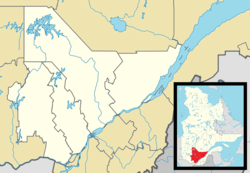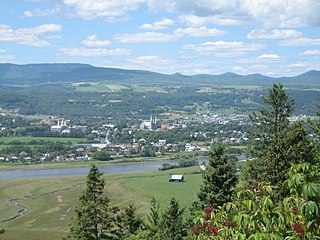
Charlevoix is a cultural and natural region in Quebec, on the north shore of the Saint Lawrence River as well as in the Laurentian Mountains area of the Canadian Shield. This dramatic landscape includes rolling terrain, fjords, headlands, and bays; the region was designated a World Biosphere Reserve by UNESCO in 1989. Administratively, it comprises the Charlevoix and Charlevoix-Est regional county municipalities within the larger Capitale-Nationale administrative region.

Baie-Saint-Paul is a city in the Province of Quebec, Canada, on the northern shore of the Saint Lawrence River. Baie-Saint-Paul is the seat of Charlevoix Regional County Municipality. The city is situated at the mouth of the Gouffre River. It is known for its art galleries, shops and restaurants.

Capitale-Nationale is one of the 17 administrative regions of Quebec. It is anchored by the provincial capital, Quebec City, and is largely coextensive with that city's metropolitan area. It has a land area of 18,797.45 km2. It reported a total resident population of 729,997 as of the Canada 2016 Census, with Quebec City having 73.7 percent of the total.

La Malbaie is a municipality in the Charlevoix-Est Regional County Municipality in the Province of Quebec, Canada, situated on the north shore of the St. Lawrence River at the mouth of the Malbaie River. It was formerly known as Murray Bay. La Malbaie is the seat of the judicial district of Charlevoix.

The Malbaie River in the Charlevoix region empties into the Saint Lawrence River at La Malbaie. Until 1985 the river was used to transport logs downstream. It flows through a steep valley known as Les Hautes Gorges. A sugar maple and American elm forest grows in the gorge and has remained largely undisturbed for hundreds of years.

Félix-Antoine Savard, was a Canadian priest, academic, poet, novelist and folklorist.

The Hautes-Gorges-de-la-Rivière-Malbaie National Park is a provincial park in the Charlevoix region of Quebec, Canada. Centring on the Malbaie River Gorge, it is the centrepiece of the UNESCO Charlevoix biosphere reserve. Despite its name, it is not in Canada's national park system, nor administered by Parks Canada. It is administered by the Société des établissements de plein air du Québec (Sépaq). The park can be reached via a local road, 30 kilometers (19 mi) northwards from Route 138 in Saint-Aimé-des-Lacs.
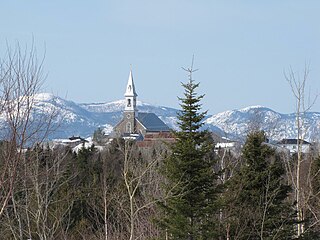
Saint-Hilarion is a parish municipality in Charlevoix Regional County Municipality, in the administrative region of Capitale-Nationale of the province of Quebec, in Canada.

Saint-Siméon is a municipality in the Charlevoix-Est Regional County Municipality of Quebec, Canada. Founded in 1869, it was named after Saint Simeon of Jerusalem.

The Charlevoix Railway is a short-line railway that operates in the Charlevoix region of Quebec Canada. From 1994 to 2009 it was a subsidiary of the Quebec Railway Corporation, a short line operator. Since April 2009 it has been owned by Train touristique de Charlevoix Inc., a Groupe Le Massif Inc. subsidiary. With a length of 144–148 kilometres (89–92 mi) it connects the city of Clermont in the Charlevoix region to a freight yard of the Canadian National Railway (CN) located in the La Cité-Limoilou borough of the city of Quebec. The railway runs along both the St. Lawrence River and the Malbaie River and consists of a single non-electrified track.
Charlevoix–Côte-de-Beaupré is a provincial electoral district in the Capitale-Nationale region of Quebec, Canada, that elects members to the National Assembly of Quebec. It consists of the entire territory of the following regional county municipalities: L'Île-d'Orléans, La Côte-de-Beaupré, Charlevoix, Charlevoix-Est. It notably includes the municipalities of La Malbaie, Boischatel, Baie-Saint-Paul, L'Ange-Gardien, Château-Richer, Beaupré, Saint-Ferréol-les-Neiges and Clermont.
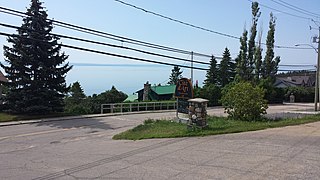
Cap-à-l'Aigle is an area located in the east end of La Malbaie, in Charlevoix-Est Regional County Municipality (RCM), in the administrative region of Capitale-Nationale, Quebec, Canada. Formerly constituted as a municipality, this territory was merged with the city of La Malbaie on December 1, 1999. This area has a mountain village on the banks of the St. Lawrence River.
Zec du Lac-au-Sable is a "zone d'exploitation contrôlée" (zec) located in the unorganized territory of Mont-Élie, in Charlevoix-Est Regional County Municipality, in administrative region of Capitale-Nationale, Quebec, Canada.
The Comporté River is a tributary of the Malbaie River flowing generally southward into the territory of the town of La Malbaie in the Eastern part of the Charlevoix Regional County Municipality, in Quebec, in Canada. This river has a gap in elevation of 489 m (1,604 ft). After several series of rapids, waterfalls and falls in forest area, it flows into the Malbaie River between the village of Clermont and the town of La Malbaie.
The Jacob River is a tributary of the north shore of the Malbaie River flowing generally southward successively into zec du Lac-au-Sable into the unorganized territory of Mont-Élie, in the city of La Malbaie and in the city of Clermont at the end of the course, in Charlevoix-Est Regional County Municipality, in Quebec, Canada.
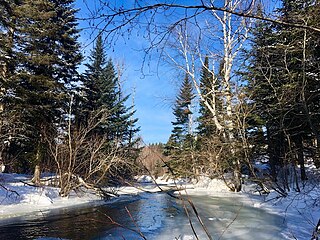
The Snigole River is a tributary of the north shore of the Malbaie River flowing generally to the south, especially in the zec du Lac-au-Sable in the unorganized territory of Mont-Élie, then in the territory of Clermont at the end of the route, in the Charlevoix-Est Regional County Municipality, in Quebec, Canada.

The Port-au-Saumon River is a tributary of the northwest shore of the St. Lawrence River, flowing into the town of La Malbaie, into the Charlevoix-Est Regional County Municipality, in the Capitale-Nationale administrative region, Quebec, Canada. The course of this river flows into the St. Lawrence River in the hamlet of Port-au-Saumon, northeast of the town of La Malbaie.

The rivière du Gouffre is a tributary of the left bank of the Saint-Laurent river, flowing into the Capitale-Nationale administrative region, Quebec (Canada). This watercourse flows through Regional County Municipality from:
The Rivière des Boudreault is a tributary of the northwest shore of the St. Lawrence River, in the municipality of Les Éboulements, in the Charlevoix Regional County Municipality, in the administrative region of Capitale-Nationale, in the province of Quebec, in Canada.

The Charlevoix Biosphere Reserve is part of the Man and the Biosphere Program of the UNESCO. It is managed by the Charlevoix Biosphere Reserve Corporation.



